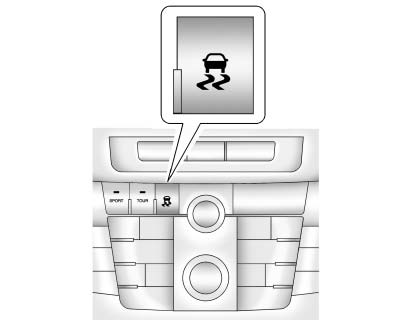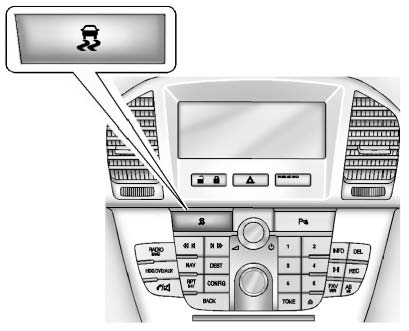Traction Control System (TCS)
The vehicle may have a Traction Control System (TCS) that limits wheel slip. The system operates if it senses that one or both of the front wheels are slipping or beginning to lose traction. When this happens, the system reduces engine power and/or applies brake pressure to the slipping wheel(s).
The system may be heard or felt while it is working, but this is normal.
TCS automatically comes on whenever the vehicle is started.
To limit wheel slip, especially in slippery road conditions, the system should always be left on. But, TCS can be turned off if needed.
 flashes to indicate that TCS is active. See Traction Control System (TCS)/StabiliTrak® Light for more information.
flashes to indicate that TCS is active. See Traction Control System (TCS)/StabiliTrak® Light for more information.
If there is a problem detected with TCS, SERVICE TRACTION CONTROL is displayed on the Driver Information Center (DIC).
See Ride Control System Messages . When this message is displayed and  comes on and stays on, the vehicle is safe to drive but the system is not operational.
comes on and stays on, the vehicle is safe to drive but the system is not operational.
Driving should be adjusted accordingly.
If  comes on and stays on, reset the system.
comes on and stays on, reset the system.
To reset:
1. Stop the vehicle.
2. Turn the engine off and waiting 15 seconds.
3. Start the engine.
If  still comes on and stays on, the vehicle needs service.
still comes on and stays on, the vehicle needs service.
Notice: Do not repeatedly brake or accelerate heavily when TCS is off. The vehicle's driveline could be damaged.
 With Interactive Drive Control System
With Interactive Drive Control System
 Without Interactive Drive Control System
Without Interactive Drive Control System
TCS can be turned off by pressing and releasing the TCS/StabiliTrak button. When TCS is turned off,  comes on, and the appropriate DIC message also displays. See Ride Control System Messages . With TCS turned off, the system does not limit wheel slip.
comes on, and the appropriate DIC message also displays. See Ride Control System Messages . With TCS turned off, the system does not limit wheel slip.
Driving should be adjusted accordingly. See Traction Off Light for more information.
Press and release the TCS/StabiliTrak button again to turn the system back on.
It may be necessary to turn the system off if the vehicle gets stuck in sand, mud, or snow and rocking the vehicle is required. See If the Vehicle Is Stuck for more information. See also Winter Driving for information on using TCS when driving in snowy or icy conditions.
Adding non-GM accessories can affect the vehicle performance.
See Accessories and Modifications for more information.
See also:
Head Restraints
The vehicle's front and rear seats
have adjustable head restraints in
the outboard seating positions.
WARNING!
With head restraints that are not
installed and adjusted properly,
there is a g ...
Off-Road Driving
This off-road guide is for vehicles that have
all-wheel drive. If your vehicle does not have
all-wheel drive, you should not drive off-road
unless you are on a level, solid surface.
Many of the ...
To Transfer Audio to the Cell Phone
During a call with the audio in the vehicle:
1. Press . The system responds with
“Ready”
followed by a tone.
2. Say “Transfer Call.” The system responds with
“Transferring call” an ...


